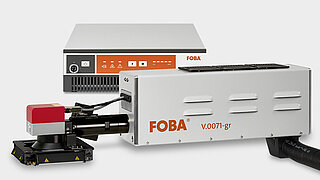Green Laser Marking System: Next Addition to FOBA’s Product Portfolio
FOBA is launching a new marking system: the "green laser" is another innovative addition to the existing range of marking lasers. Philipp Febel, Director Product Management, answers questions about the new laser system and provides insights into product development.

What is a green laser, and how does this marking system differ from other FOBA products?
The green laser has a wavelength of 532 nanometers, putting it in the middle of the visible – and in this case green – wavelength range. Compared to our infrared marking lasers, which have a wavelength of 1,064 nanometers, the heat input from the green laser is relatively low. Our UV lasers have even less impact on the surface. This is because they affect the material by photochemical reaction instead of heat.
What are FOBA's reasons for developing the green marking laser?
As with all new or further developments of our products, we respond to customer and market requirements. In this case, we were confronted with application requirements that are traditionally addressed with the UV laser because they involve heat-sensitive surfaces. However, there were materials where the UV marking laser could not achieve the required contrast sharpness.
With the green laser, we are closing the gap between UV and infrared lasers. Our marking tests on the corresponding materials really convinced us: Not only were we able to achieve the best contrasts with the green laser, but in many cases we were also able to mark twice as fast as with the UV systems!
How do you explain this marking performance?
Certain materials have a high absorption behavior in the green and UV wavelength range. Combined with a very high power of up to 14 watts in this range, we achieve the best results – and even at high speed.
How does the integration of the new system into existing production lines work?
Due to the relatively compact design, installation is easily feasible. All common interfaces and communication protocols are possible during integration. As far as operation is concerned: We will also be offering browser-based control with FOBA Go together with the green laser in addition to the familiar FOBA software, which then eliminates the need for a PC to control the marking process. We have also succeeded in making the laser head so compact that the green laser will be able to be integrated into our M-series marking workstations.
What are the application areas the green laser is intended for?
The system is suitable for marking white, transparent, or even softer, highly flexible plastics, such as those often used in medical technology. In the case of plastics, we have also seen that convincingly good contrasts can be achieved on red or orange surfaces. Another particularly advantageous aspect is that the green laser largely eliminates the need for laser additives in the plastic.
However, the green laser is also suitable for glass-fiber-reinforced plastics or for highly reflective precious metals. Here, the wavelength of the green laser accommodates the respective absorption behavior of the material.
What advantages – apart from marking quality – does FOBA offer with the new system?
Our customers come from highly regulated industries, they are medical technology manufacturers or automotive OEMs, where laser marking must not only create permanently and reliably readable characters. Additional factors such as process reliability also count, which means that the marking technology must sustainably meet the required standards.
Since our green laser can be combined with the camera based FOBA workflow, the marking process is simplified even further. As usual, our customers can therefore rely on the proven IMP technology with intelligent marking alignment as well as integrated part and mark inspection.
An example here is UDI marking in medical device manufacturing: Here, our customers rely on our systems being verifiable in accordance with legal requirements. Above all, they expect expert advice prior to the installation of the laser system to be on the safe side here.
Another major advantage is the marking speed. This comes into play, for example, in automotive production, where the cycle times of direct marking are crucial due to the fast lines. With the green laser, we thus offer a great possible added value in terms of speed!
What are the costs for FOBA‘s green laser?
The acquisition costs are about the same compared to a UV laser. However, if you then consider the service life of the laser source, it quickly becomes clear that you are driving very favorably in terms of TCO, i.e., the total cost of ownership of the system over the period of its service life. In addition, as with the other FOBA systems, you can assume that extremely low maintenance requirements and as good as no consumables will keep follow-up costs low.
How fast can FOBA deliver the green laser?
Due to the current market situation and the general shortage of materials, delivery delays are currently to be expected more than usual. However, we are still able to realize our usual short delivery times. Thus, we are currently assuming a twelve-week delivery margin.
From a personal perspective, what is the most exciting thing about the new product?
Personally, I have found the close cooperation within the FOBA team and with the customers extremely rewarding. Now I am looking forward to seeing the result in practical use and, above all, to witnessing how the industries benefit from it. Our goal is always to provide optimum technology in order to implement direct part marking for our customers in a comprehensive and service-oriented manner. This will also succeed with the green laser, and I am looking forward to seeing which marking requirements and which materials our green lasers will prove themselves with in practice.